(→Energy from the Sun: fixed link) |
Anonymous1 (talk | contribs) |
||
| Line 13: | Line 13: | ||
==Applications== | ==Applications== | ||
Being as there are, on a global scale, near countless applications using domestic, commercial and industrial hot water, there are also many opportunities to apply solar thermal technologies to heat this water. | Being as there are, on a global scale, near countless applications using domestic, commercial and industrial hot water, there are also nearly as many opportunities to apply solar thermal technologies to heat this water. | ||
But today the market is changing, and both the economic and environmental costs associated with using gas and electricity to heat water are being challenged by more efficient, less costly systems. | But today the market is changing, and both the economic and environmental costs associated with using gas and electricity to heat water are being challenged by more efficient, less costly systems. | ||
Revision as of 19:56, 14 January 2008
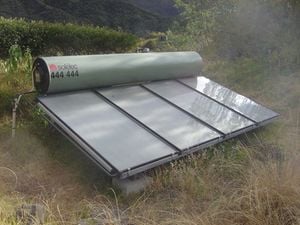
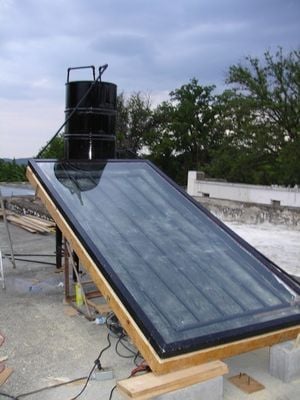

Introduction
Solar hot water describes active and passive solar technologies that utilize the sun’s freely abundant solar thermal energy in order to heat water for a desired application.
It is one of the most efficient ways to heat water (in terms of energy/waste), as it requires no energy conversion, unlike electric-resistance heating or fuel burning. It is a simple transfer and concentration of heat energy from one place to another. See Wikipedia:Heat transfer.
If you have ever felt hot water trickle out of a garden hose that’s been sitting in the sun, you’ve experienced solar hot water in action.
Essentially, a solar hot water system is made up of a solar thermal collector, a well-insulated storage container, and a system for transferring the heat from the collector to the container vis-à-vis a fluid medium, which in some circumstances is the water to be used itself.
Applications
Being as there are, on a global scale, near countless applications using domestic, commercial and industrial hot water, there are also nearly as many opportunities to apply solar thermal technologies to heat this water.
But today the market is changing, and both the economic and environmental costs associated with using gas and electricity to heat water are being challenged by more efficient, less costly systems.
Background
Solar hot water is not a new phenomena. It was widely used in the United States up into about the 1920's when it was displaced by cost-effective, consistent, fossil fuel reliant systems.
Hot water is considered by some to have less application in the field of appropriate technology and to mostly be a luxury afforded the developed world. One text[verification needed] on the subject suggests that what hot water is needed in the "3rd World" can be heated using a fuel such wood that simultaneously heats the home. Such dismissals are dangerous on two counts:
- First, if appropriate technology is at all concerned with reducing waste and increasing efficiency in use of precious natural resources, then there appear to be many opportunities to do so using solar thermal energy and technologies that utilize it in the context of appropriate technology and sustainable development.
- Second, the potential to displace the ecological, economic and social externalities associated with W in the more affluent and developed regions on the planet is crucial. It is imperative that where there is a path dependency to use hot water regularly and in abundance, even for such luxuries as long, hot showers, clothes washing and heated tubs and pools is extremely important for many SDHW applications are cost-effective and available and thus there could be a significant reduction in the size of a regions Ecological Footprint associated with conventional means of heating water (site Wiki for conventional hot water).
Energy from the Sun
See original article: W
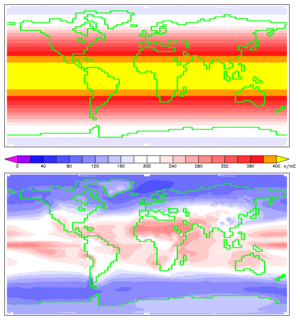
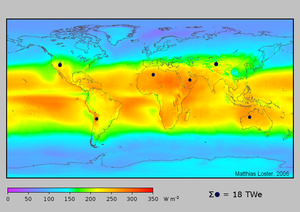
Solar radiation reaches the Earth's upper atmosphere at a rate of 1366 watts per square meter (W/m2).[1] The first map shows how the solar energy varies in different latitudes.
While traveling through the atmosphere, 6% of the incoming solar radiation (insolation) is reflected and 16% is absorbed resulting in a peak irradiance at the equator of 1,020 W/m². Average atmospheric conditions (clouds, dust, pollutants) further reduce insolation by 20% through reflection and 3% through absorption. Atmospheric conditions not only reduce the quantity of insolation reaching the Earth's surface but also affect the quality of insolation by diffusing incoming light and altering its spectrum[2].
The second map shows the average global irradiance calculated from satellite data collected from 1991 to 1993. For example, in North America the average insolation at ground level over an entire year (including nights and periods of cloudy weather) lies between 125 and 375 W/m² (3 to 9 kWh/m²/day).[3] This represents the available power, and not the delivered power. At present, photovoltaic panels typically convert about 15% of incident sunlight into electricity; therefore, a solar panel in the contiguous United States on average delivers 19 to 56 W/m² or 0.45 - 1.35 kWh/m²/day.[4]
The dark disks in the third map on the right are an example of the land areas that, if covered with 8% efficient solar panels, would produce slightly more energy in the form of electricity than the total world primary energy supply in 2003.[5]. While average insolation and power offer insight into solar power's potential on a regional scale, locally relevant conditions are of primary importance to the potential of a specific site.
After passing through the Earth's atmosphere, most of the sun's energy is in the form of visible and infrared radiation. Plants use solar energy to create chemical energy through photosynthesis. Humans regularly use this energy burning wood or fossil fuels, or when simply eating the plants.
A recent concern is global dimming, an effect of pollution that is allowing less sunlight to reach the Earth's surface. It is intricately linked with pollution particles and global warming, and it is mostly of concern for issues of global climate change, but is also of concern to proponents of solar power because of the existing and potential future decreases in available solar energy. About 4% less solar energy is available at sea level over the timeframe of 1961–90, mostly from increased reflection from clouds back into space.[6]
Appropriate Technology
System Types
Availability of Solar Thermal Energy
Hot water can be used for a number of applications, including sanitation (it's easier to wash a lot of things with hot water), and space heating.
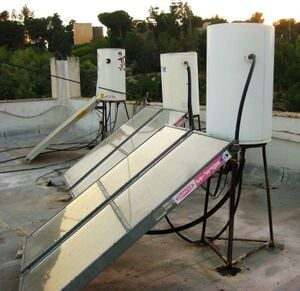

References
- ↑ Solar Spectra: Standard Air Mass Zero NREL Renewable Resource Data Center
- ↑ Earth Radiation Budget NASA Langley Research Center
- ↑ Solar Maps NREL: Dynamic Maps, GIS Data, and Analysis Tools
- ↑ us_pv_annual_may2004.jpg National Renewable Energy Laboratory, US
- ↑ Homepage International Energy Agency
- ↑ Liepert, B. G. (2002-05-02) Observed Reductions in Surface Solar Radiation in the United States and Worldwide from 1961 to 1990 GEOPHYSICAL RESEARCH LETTERS, VOL. 29, NO. 10, 1421